
This team was the last one I did design work on, as it was the hardest to put together in the early stages. I’ve already written about how it was a risk to separate the International and European teams from the JLA and make them their own team. Once that move was approved, the team roster was fairly easy to fill, but the tough choice was what to do with all of the characters who were a part of the JLA and the international teams. In the end, I decided to have only the founding members of the JLI show up on both teams—Batman, Black Canary, and Martian Manhunter.
My original idea for the JLI was for it to be an off-curve team. The international characters are, for the most part, less powerful than the classic JLA. However, the concept of the “while you control four or less resources” theme didn’t come to me until a few weeks before I turned over the set to development. In fact, the early off-curve theme I had going for the team had many characters that grew based on the number of resources you controlled.
My secondary idea for the team was to give them a lot of resource payment powers, which really helps off-curve teams. I really liked this design direction Mike took with the Masters of Evil concept, and I wanted to continue it.
Below, you can see the evolution of some of the JLI characters and how the team evolved into the deadly stunted-curve team you see today.
Key
Original: November 2004. By the middle of this month, I had given each character in the set a “first pass” power. These are heavily thematic powers that helped me to see where team themes might present themselves.
Turnover: March 8, 2005. This is the day I turned over my design file to the developers.
Development: April 19, 2005—a week after ally became what you see today. Sometimes the development team made changes. Sometimes they came to me asking for a rewrite.
Final: This is the text you see on the card today.
Ted Kord ◊ Blue Beetle
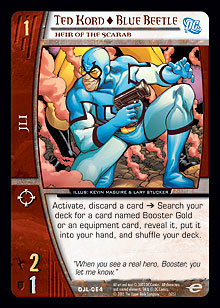 Original
Original
He started out as a 2-cost 3 ATK / 3 DEF.
“While equipped, Blue Beetle gets +1 ATK / +1 DEF. <p> Pay 1 resource point >>> Search your deck for an equipment card, reveal it, and put it into your hand. Shuffle your deck.”
He’s a gadgeteer, so equipment effects were a natural. But as a beloved character, I wanted him to do a bit more.
Turnover
Now he’s a 1-cost 2 ATK / 1 DEF.
“Pay 1 resource point >>> Search your deck for an equipment card with cost 1 or less and equip it to Blue Beetle. Shuffle your deck. Use this power only if Blue Beetle is unequipped. <p> Pay 1 resource point >>> Search your deck for a character card named Booster Gold, reveal it, and put it into your hand. Shuffle your deck.”
I’ve got all the pieces in place, but two separate resource point payment powers was a lot of text.
Development
“Pay 1 resource point >>> If Blue Beetle is unequipped, search your deck for an equipment card with cost 1 or less, equip it to Blue Beetle, and shuffle your deck. <p> Activate, discard a card >>> Search your deck for a character card named Booster Gold, reveal it, put it into your hand, and shuffle your deck.”
The “activate and discard a card” was in place, but there was still too much text. That, and Development was trying to remove the resource payment powers, as it was too soon after Masters of Evil to revisit them.
Final
Ted Kord ◊ Blue Beetle, Heir of the Scarab
“Activate, discard a card >>> Search your deck for a card named Booster Gold or an equipment card, reveal it, put it into your hand, and shuffle your deck.”
Now both previous powers are tidied up into one simple activated power.
Maxwell Lord
Original
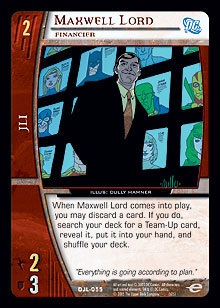 He started out as a 1-cost 1 ATK / 1 DEF.
He started out as a 1-cost 1 ATK / 1 DEF.
“When Maxwell Lord comes into play, search your deck for a card named World’s Greatest Heroes, reveal it, and put it into your hand. Shuffle your deck. <p> Leadership: Adjacent characters gain the JLI team affiliation.”
He’s the guy who really put the JLI on the map, so I wanted his power to reflect his “team-builder” status. Note that leader was originally called leadership.
Turnover
He’s now a 2-cost 1 ATK / 4 DEF.
“When Maxwell Lord comes into play, search your deck for a card with version Team-Up, reveal it, and put it into your hand. Shuffle your deck. <p> Leader: Pay 1 resource point >>> Adjacent characters can’t be targeted by effects opponents control this turn.”
Now he could search for any Team-Up, and his leader power showed that he had some powers of the mind. At this point, the “anti-plot twist” theme crossed over between the JLA and JLI.
Development
He’s now a 2-cost 2 ATK / 3 DEF.
“When Maxwell Lord comes into play, you may discard a card. If you do, search your deck for a Team-Up card, reveal it, put it into your hand, and shuffle your deck. <p> Leader: While a character adjacent to Maxwell Lord is attacking and has two or more team affiliations, it gets +1 ATK.”
A discard was added to his coming-into-play power, as it had proved too good. And now his leader power encouraged teaming up, but it turned out to be a bit clunky, as it was a no-brainer that characters adjacent to him would have two affiliations.
Final
Maxwell Lord, Financier
“When Maxwell Lord comes into play, you may discard a card. If you do, search your deck for a Team-Up card, reveal it, put it into your hand, and shuffle your deck.”
Now he’s not a huge block of text.
Booster Gold
Original
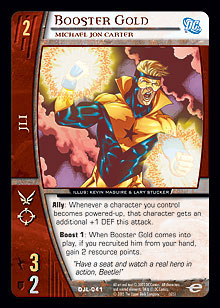 He started out as a 4-cost 9 ATK /5 DEF.
He started out as a 4-cost 9 ATK /5 DEF.
“Pay 1 resource point >>> Booster Gold cannot be stunned while attacking this turn. <p> Boost 1: Gain 2 resource points. You may only use these points to pay for payment powers.”
This was part of my early resource point theme. And giving boost to Booster was just too good to pass up. However, I realized that I wasn’t giving his force field powers any props.
Turnover
He’s now a 2-cost 2 ATK / 2 DEF.
“Whenever Booster Gold becomes powered-up, target character you control gets +2 DEF this turn. <p> Boost 1: When Booster Gold comes into play, gain 2 resource points. You can’t use these resource points to recruit character cards.”
This power was pre-ally, so when he powered-up, he included a buddy (or himself) in his force field—pretty powerful. However, it’s not very heroic just to stand there and not help out when that buddy is being attacked.
Development
He’s now a 2-cost 3 ATK / 2 DEF.
“Ally: Whenever a character you control would become powered-up, instead, you may give it +2 DEF this attack. <p> Boost 1: When Booster Gold comes into play, gain 2 resource points.”
Now he could help out a friend in need, but the “instead” replaced the power-up, which isn’t as helpful as an ally. However, development soon broke his boost power by way of Witching Hour, so he needed one little nerf.
Final
Booster Gold, Michael Jon Carter
Ally: Whenever a character you control becomes powered-up, that character gets an additional +1 DEF this attack. <p> Boost 1: When Booster Gold comes into play, if you recruited him from your hand, gain 2 resource points.”
Tacking on the “from hand” requirement to his boost finally made him fair.
Rocket Red #4
Original
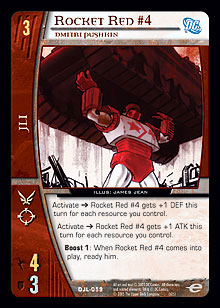 He started out as a 3-cost * ATK / * DEF.
He started out as a 3-cost * ATK / * DEF.
“When Rocket Red comes into play, choose an opponent. Rocket Red’s ATK and DEF are equal to the total number of face-down resources you and that opponent control. <p> Pay 2 resource points >>> Turn a resource you control face down.”
I must have been putting a bit too much stock in the fact that his armor was from Apokolips, as this power belongs in the Darkseid’s Elite. Or nowhere . . .
Turnover
He’s now a 3-cost 4 ATK / 3 DEF.
“Pay 1 resource point >>> Ready Rocket Red #4. Use this power only once per turn. <p> Activate >>> Rocket Red #4 gets +1 DEF this turn for each resource you control.”
I still couldn’t get away from the resource point powers, but I gave him stats and an activating power. You can see the final card forming.
Development & Final
“Activate >>> Rocket Red #4 gets +1 DEF this turn for each resource you control. <p> Activate >>> Rocket Red #4 gets +1 ATK this turn for each resource you control. <p> Boost 1: When Rocket Red #4 comes into play, ready him.”
Switching the resource payment to a boost did the trick; this version survived through development and is the card you see today. It was almost changed because Mike thought players would be confused by the boost power. He was right, but enough “got it” to overcome that.
Batman
Original
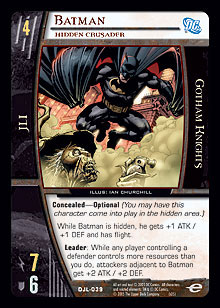 He started out as a 6-cost 12 ATK / 12 DEF.
He started out as a 6-cost 12 ATK / 12 DEF.
“Leader: Adjacent characters with a cost of 4 or less get +2 ATK while defending. <p> Adjacent JLI characters with a cost of 4 or less get +2 DEF while defending.”
Looking at this character for three months was probably the genesis of the “four or less” theme, but in this case, it referred to cost, not the resources.
Turnover
He’s now a 4-cost 8 ATK / 6 DEF.
“Leader: Pay 1 resource point >>> While defending this turn, adjacent characters get +1 ATK for each resource you control less than six. <p> Boost 1: Batman gets flight and +1 DEF for each resource you control this turn.”
I’m back to the resource point powers, but the seeds of the reduced resource build are starting to form. However, this wording was quite clunky.
Development
“Concealed-Optional <p> While Batman is hidden, he gets +1 DEF and has flight. <p> Leader: Characters adjacent to Batman cannot be stunned while attacking a defender whose controller controls more resources than you.”
I suddenly remembered that we didn’t have a black-bordered Batman and knew I had to correct that. The development team wanted to get away from the “cannot be stunned” wording that was so common in Avengers, so . . .
Final
Batman, Hidden Crusader
“Concealed-Optional <p> While Batman is hidden, he gets +1 ATK / +1 DEF and has flight. <p> Leader: While any player controlling a defender controls more resources than you do, attackers adjacent to Batman get +2 ATK / +2 DEF.”
A stat boost for adjacent attackers still allows for combat interaction, which makes the game interesting. Because of this slight nerfing, he gained an extra point of ATK while hidden.
Fire
Original
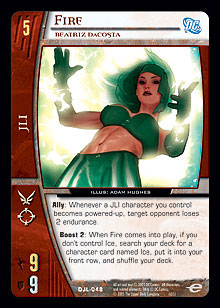 She started out as a 5-cost 8 ATK / 8 DEF.
She started out as a 5-cost 8 ATK / 8 DEF.
“Characters you control named Ice get +1 ATK / +1 DEF. <p> Boost 2: When Fire comes into play, put a character card named Ice from your hand into your front row.”
Ice increased Fire’s stats, so her stats were very weak. As you can see, the boost was there from the start.
Turnover
It’s now a 5-cost 9 ATK / 9 DEF.
“Whenever Fire becomes powered-up, target player loses 4 endurance. <p> Activate >>> Power-up target character you control named Ice. <p> Boost 3: Search your deck for a card named Ice and put it into your front row. Shuffle your deck.”
She and Ice both had power-up triggers and could activate to power-up each other. Her boost increased one, as you could search for Ice, and the combo was strong.
Development
“Ally: Whenever a character you control would become powered-up, instead, you may have target player lose 2 endurance. <p> Boost 2: When Fire comes into play, search your deck for a character card named Ice and put it into your front row. Shuffle your deck.”
The “instead” in the ally power didn’t provide much synergy with other allies. In our early testing of ally, “instead” was used to nerf allies. Not a good idea.
Final
Fire, Beatriz DaCosta
“Ally: Whenever a JLI character you control becomes powered-up, target opponent loses 2 endurance. <p> Boost 2: When Fire comes into play, if you don’t control Ice, search your deck for a character card named Ice, put it into your front row, and shuffle your deck.”
Tasmanian Devil
Original
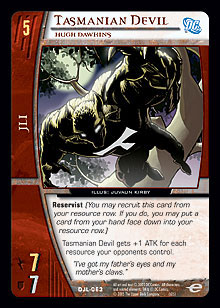 He started out as a 5-cost * ATK / 7 DEF.
He started out as a 5-cost * ATK / 7 DEF.
“Loyalty <p> Tasmanian Devil’s ATK is equal to twice the number of resources you control.”
Here’s an example, like Rocket Red, of counting your own resources. On the turn he comes out, he’d be a 10 ATK / 7 DEF and would take down most 6- and 7-drops on those turns—a bit too good.
Turnover
He’s now a 5-cost 6 ATK / 7 DEF.
“Reservist <p> Tasmanian Devil gets +1 ATK for each resource you control.”
I abandoned the * stats and gave him an actual ATK score that increased, but he’s still a 10 ATK / 7 ATK on turn 5. No longer broken, I dropped the loyalty and started finding thematically reservist characters in the set.
Development & Final
He’s now a 5-cost 7 ATK / 7 DEF.
“Reservist <p> Tasmanian Devil gets +1 ATK for each resource your opponents control.”
It was during development that the “four or less” theme came into being, and this card survived unchanged for the last two months.
Martian Manhunter
Original
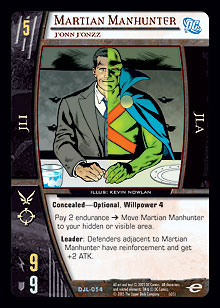 He started out as a 5-cost 9 ATK / 8 DEF.
He started out as a 5-cost 9 ATK / 8 DEF.
“Concealed, Leadership: Adjacent characters cannot be stunned while attacking. <p> Cosmic: At the start of the combat phase, you may move any number of characters you control to the hidden area.”
I didn’t keep this version too long, as I wanted him to work better as a defender. I also wanted to bring back another older concept.
Turnover
He’s now a 5-cost 10 ATK / 11 DEF.
“Concealed-Optional, Willpower 4, Loyalty. You must control a JLA character to recruit Martian Manhunter. <p> Leader: Adjacent characters with cost less than or equal to Martian Manhunter’s willpower can’t be stunned while attacking.”
I thought it might be fun to bring back double loyalty, which was last seen in Marvel Knights. And since I now gave him willpower, I thought it would be nice to reference it. However, I soon realized that J’Onn should be willing to work on either JL team, not only when combined. He’s too important to all Leagues.
Development
He’s now a 5-cost 9 ATK / 9 DEF.
“Concealed-Optional, Willpower 4 <p> Leader: Adjacent characters with cost less than or equal to Martian Manhunter’s willpower have invulnerability.”
My intention was to make him good on defense, but this version was way too good on the attack. Defensive leader powers are tough, as the leader can be taken down first, so all the adjacent characters lose the leader bonus.
Final
Martian Manhunter, J’Onn J’Onzz
“Concealed—Optional, Willpower 4 <p> Pay 2 endurance >>> Move Martian Manhunter to your hidden or visible area. <p> Leader: Defenders adjacent to Martian Manhunter have reinforcement and get +2 ATK.”
Now he’s the ultimate defensive leader, as you can get him out of harm’s way, but bring him back to give a character under attack a big benefit.
Dr. Fate
Original
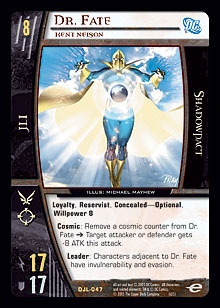 He started out as an 8-cost 19 ATK / 19 DEF.
He started out as an 8-cost 19 ATK / 19 DEF.
“Activate >>> Remove target character with a cost of 6 or less from the game.”
The man can do anything, but sometimes too much design space leaves one unable to come up with anything interesting.
Turnover
He’s now a 8-cost 17 ATK / 17 DEF.
“Loyalty <p> Pay 1 endurance >>> Move Dr. Fate to your hidden or visible area. <p> Leader: Adjacent characters have invulnerability and evasion. <p> Cosmic: Dr. Fate has invulnerability, evasion, and willpower 5. <p> Boost 1: Gain 9 endurance.”
I talked to R&D’s DC expert, Kevin Tewart, in the hopes of getting some design direction. The first words out of his mouth were, “He should have every keyword and should be able to remove himself from combat at will.” The boost 1 seemed a bit dumb, though.
Development
“Loyalty, Concealed-Optional, Willpower 8 <p> Cosmic: Dr. Fate has invulnerability. <p> Remove a cosmic counter from Dr. Fate >>> Target attacker or defender gets -X ATK this attack, where X is Dr. Fate’s willpower. <p> Leader: Adjacent characters have invulnerability and evasion.”
How could I have denied him concealed-optional? And instead of removing himself from combat, I thought he should just negate an attack. But why bother if he is invulnerable? It was a bi too much, even for him.
Final
Dr. Fate, Kent Nelson
“Loyalty, Reservist, Concealed-Optional, Willpower 8 <p> Cosmic: Remove a cosmic counter from Dr. Fate >>> Target attacker or defender gets -8 ATK this attack. <p> Leader: Characters adjacent to Dr. Fate have invulnerability and evasion.”
We were close to putting the boost back on (and tried to find a way to add transferable) just for the humor value, but reservist made the cut instead. And what do you give the man who has everything? Something that no other character has ever had before: a preview of an upcoming team. This was the last card to receive a second team affiliation, as we had to ask DC’s permission to do it and that took some time.
Dr. Fate was simply the icing on the cake for a team of crazy characters. Some are crazy with their hare-brained schemes and practical jokes. Others just have crazy powers. I mean, Metamorpho has an optional modal power. If you don’t know what that means, I’ll spell it out: a headache for our rules team. I’m sure they had fun. This team is so much fun I knew from the start that I wanted Blue Beetle and Booster Gold to be the Sneak Preview stacker cards and herald the coming of the Justice League set.
Next week, you’ll see the evolution of the Injustice Gang team. Don’t forget to email me if you want to see a fifth article tracking the evolution of your favorite non-character cards in the JLA set. Just be sure to mention your favorite card.
Send questions or comments to mhyra@metagame.com.